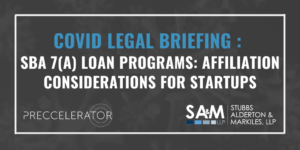 The Coronavirus Aid, Relief, and Economic Security (CARES) Act was recently signed into law, and includes, among other things, a new loan type under the 7(a) loan program of the Small Business Administration (SBA), called the Paycheck Protection Program (PPP). Also available under the SBA framework are Economic Injury Disaster Loans (EIDLs). Our focus here is specifically on potential issues emerging growth companies may face in the context of these loan programs regarding deemed “affiliation” between a company and its investors.
The Coronavirus Aid, Relief, and Economic Security (CARES) Act was recently signed into law, and includes, among other things, a new loan type under the 7(a) loan program of the Small Business Administration (SBA), called the Paycheck Protection Program (PPP). Also available under the SBA framework are Economic Injury Disaster Loans (EIDLs). Our focus here is specifically on potential issues emerging growth companies may face in the context of these loan programs regarding deemed “affiliation” between a company and its investors.
Why does affiliation matter? Understanding whether an applicant’s investors will be deemed to be affiliated is important to ensure that an applicant does not breach a maximum level of employees required for eligibility under the loan programs. In order to be eligible for 7(a) loan programs, an applicant must employ no more than 500 employees.[1] For many early-stage companies, the 500 employee threshold would at first glance appear to be easily satisfied, but the SBA 7(a) loan programs require that an applicant includes in its headcount the employees of any companies under common control, or affiliated, with the applicant. For the SBA’s purposes, affiliation is defined more broadly than in many other contexts, and currently available guidance suggests that some common contractual rights held by venture capital investors could trigger a finding that an investor such as a VC fund would be affiliated with the applicant and that in turn the other portfolio companies of such fund would be deemed affiliates and be required to be included for purposes of the 500 employee threshold.
What triggers a finding of “affiliation”? There are several bases on which affiliation may be found, including the following:[2]
1. Majority ownership. This is likely the easiest category to assess. If an investor owns more than 50% of the voting equity, that investor controls the company and shall be affiliated with the company, along with any other companies that such investor controls.
2. Veto rights, aka protective provisions or negative controls.
a. This is the category that has caused the most confusion in the startup ecosystem. A minority investor may, notwithstanding the minority ownership position, be deemed an affiliate based on its ability to negatively control (i.e., have veto power over) the applicant’s operations. Since most VC investors take minority positions, this is where most of the action is for assessing a startup’s likelihood of triggering a finding of affiliation with its investors.
b. There is, unfortunately, no bright-line list of triggering provisions, but there are past decisions by the SBA Office of Hearings and Appeals (OHA) from which guidance can be drawn. Generally, the SBA focuses a finding of affiliation by negative control on whether the negative controls are operational in nature, as opposed to fundamental matters seen as reasonable for protection of a minority investor’s interests. Thus, a right to veto a sale of the company is unlikely to result in a finding of affiliation, but a right to veto capital expenditures probably would trigger such a finding.
c. The National Venture Capital Association (NVCA) has put out a helpful summary of veto rights that, based on past OHA determinations, are likely to trigger a finding of affiliation with an investor holding any such rights (though it is important to bear in mind that removing any such negative controls does not guarantee that no finding of affiliation will be found). Those veto rights that are likely to be problematic are summarized below:[3]
i. Making distributions or paying dividends (other than tax distributions).
ii. Establishing a quorum for a board or stockholders meeting.
iii. Approving the budget or capital expenditures outside the budget.
iv. Determining employee compensation.
v. Hiring and firing officers.
vi. Changing the company’s strategic direction.
vii. Establishing or amending an option plan.
ix. Incurring or guaranteeing debts.
x, Initiating or defending a lawsuit.
xi. Entering into contracts or joint ventures.
xii. Amending or terminating leases.
d. A couple of additional important considerations:
i. Negative control is assessed not only with respect to the investor entity as an equity holder having blocking rights but also where an investor-appointed director has the ability to block actions at the board level.
ii. Negative control is assessed with respect to a minority investor acting alone. However, this does not mean that the investor must have a right granted specifically to them; rather, a company must look at its ownership. For instance, if negative controls are granted to a company’s Series A holders as a group, and a single investor holds a majority of the Series A voting power, that investor constructively holds the veto right and will be found to hold those negative controls. In contrast, if an investor holds a large portion of the Series A but not a majority, this large ownership stake alone is unlikely to result in a finding that such investor holds those negative controls, because they do not, acting individually, have a blocking right.
3. Convertible or exercisable securities, or agreements to sell. The SBA will give present effect, i.e. deem to have occurred for purposes of the affiliation analysis, any convertible instruments or agreements to sell. This includes, for instance, taking into account exercisable securities for calculating ownership thresholds, as well as in certain cases letters of intent to merge or sell securities.
4. Management. Entities under common management may be deemed to be affiliated. This may include, for instance, where one entity controls the management of the applicant through a management agreement, or where one or more officers of the applicant control the management and/or the board of one or more other entities.
What if an investor has rights that would trigger affiliation, but they do not exercise them? For purposes of the SBA 7(a) loan programs, affiliation is measured based on rights held, regardless of whether such rights are exercised.
What actions should a startup take now? We recommend all startup companies applying for an SBA 7(a) loan familiarize themselves with the rights held by their investors. If an applicant has agreements in place with investors that are likely to trigger a finding of affiliation, it may be possible to amend those agreements to mitigate the likelihood of a finding of affiliation.
Will these guidelines change? There are substantial efforts in progress by the NVCA and other groups lobbying for guidance to clarify affiliation matters and ensure that startups are not inadvertently deemed affiliated with their investors by virtue of control provisions. There is no guarantee such efforts will be successful, and unless and until they are, companies will need to operate assuming the currently available guidance will apply. On Thursday April 2, 2020, House Minority Leader Kevin McCarthy (R-Calif.) told the Axios Pro Rata Podcast[4] that he spoke with Treasury Secretary Mnuchin and that guidance would be forthcoming in a couple of days to set out clearer guidelines for PPP loan eligibility.
Author: Caroline Cherkassky
The attorneys of Stubbs Alderton & Markiles, LLP are continuously monitoring the current COVID-19 situation and publishing relevant updates that pertain to your business. Contact one of our legal professionals at info@stubbsalderton.com, if you have any questions.
For more information please visit our COVID-19 Resources page.
[1] Note that there are exceptions for certain franchises or applicants in the hotel or foodservice industry, but these exceptions will not be relevant for most technology or other startups.
[2] This is a non-exhaustive list of the bases most likely to be relevant for startups. See 13 CFR §121.301(f) for a complete listing.
[3] See NVCA Affiliation in the Context of SBA Loans – Guidance for Venture Capital Investors at https://nvca.org/wp-content/uploads/2020/03/VC-SBA-Lending-and-Affiliation-Guidance-for-SBA-Loan-Programs.pdf
[4] See https://www.axios.com/coronavirus-vc-startups-small-business-loans-6ae9e125-fbbb-4349-9d67-ce68d4a5ac57.html.

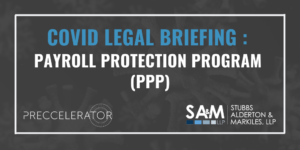 Making payroll is one of the most stressful issues on every business owner’s mind, and thankfully, the Paycheck Protection Program (PPP) section of the CARES Act provides significant aid to provide some financial relief. The final PPP loan application is now available
Making payroll is one of the most stressful issues on every business owner’s mind, and thankfully, the Paycheck Protection Program (PPP) section of the CARES Act provides significant aid to provide some financial relief. The final PPP loan application is now available 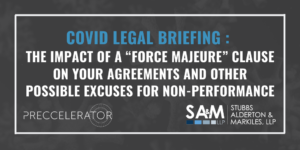 Force Majeure provisions in an agreement may excuse performance by one or both parties to a contract as a result of events that can neither be anticipated nor controlled. These provisions range from simple and boilerplate to extraordinarily detailed. But you may also be excused from performance of a contract if performance of the agreement impossible or impracticable.
Force Majeure provisions in an agreement may excuse performance by one or both parties to a contract as a result of events that can neither be anticipated nor controlled. These provisions range from simple and boilerplate to extraordinarily detailed. But you may also be excused from performance of a contract if performance of the agreement impossible or impracticable.

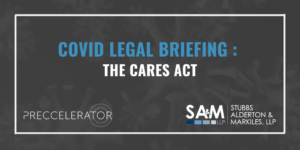 Signed into law on March 27, 2020, The Coronavirus Aid, Relief and Economic Security Act — or “CARES Act”, among other things, provides significant relief for small businesses. The Act injects roughly $2 trillion into the economy for coronavirus relief – providing roughly $350 billion in small business loans and an additional $500 billion in relief to distressed companies in distressed industries, expanding unemployment compensation, and providing rebate checks/tax relief to individuals, families and businesses. This relief is intended to last 3 months.
Signed into law on March 27, 2020, The Coronavirus Aid, Relief and Economic Security Act — or “CARES Act”, among other things, provides significant relief for small businesses. The Act injects roughly $2 trillion into the economy for coronavirus relief – providing roughly $350 billion in small business loans and an additional $500 billion in relief to distressed companies in distressed industries, expanding unemployment compensation, and providing rebate checks/tax relief to individuals, families and businesses. This relief is intended to last 3 months.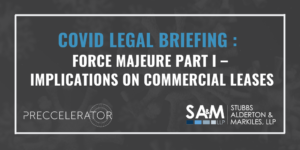 With the COVID-19 pandemic raging, businesses are concerned about whether this event will excuse their performance of agreements they entered into prior to the pandemic, and with the beginning of a new month fast approaching whether to pay the rent on their leases, while landlords are engaged in the same thought process of wondering if the rent checks are going to timely arrive. That dilemma is especially acute in places like California, with Governor Newsom’s stay-at-home order made on March 19 and its impact on all businesses and the rapidly emptying commercial and non-essential retail space.
With the COVID-19 pandemic raging, businesses are concerned about whether this event will excuse their performance of agreements they entered into prior to the pandemic, and with the beginning of a new month fast approaching whether to pay the rent on their leases, while landlords are engaged in the same thought process of wondering if the rent checks are going to timely arrive. That dilemma is especially acute in places like California, with Governor Newsom’s stay-at-home order made on March 19 and its impact on all businesses and the rapidly emptying commercial and non-essential retail space.
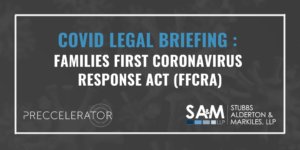 Families First Coronavirus Response Act (FFCRA)
Families First Coronavirus Response Act (FFCRA) The U.S. Small Business Administration (SBA) has announced that it has made Economic Injury Disaster Relief Loans (EIDLs) of up to $2 million available to qualifying small businesses suffering substantial economic injury as a result of the Coronavirus (COVID-19). An EIDL is a working capital loan to help qualifying small businesses to meet their ordinary and necessary financial obligations that cannot be met as a direct result of the disaster. These loans are intended to assist through the disaster recovery period. The interest rate for small businesses is 3.75%, while the interest rate for non-profit organizations is 2.75%.
The U.S. Small Business Administration (SBA) has announced that it has made Economic Injury Disaster Relief Loans (EIDLs) of up to $2 million available to qualifying small businesses suffering substantial economic injury as a result of the Coronavirus (COVID-19). An EIDL is a working capital loan to help qualifying small businesses to meet their ordinary and necessary financial obligations that cannot be met as a direct result of the disaster. These loans are intended to assist through the disaster recovery period. The interest rate for small businesses is 3.75%, while the interest rate for non-profit organizations is 2.75%.